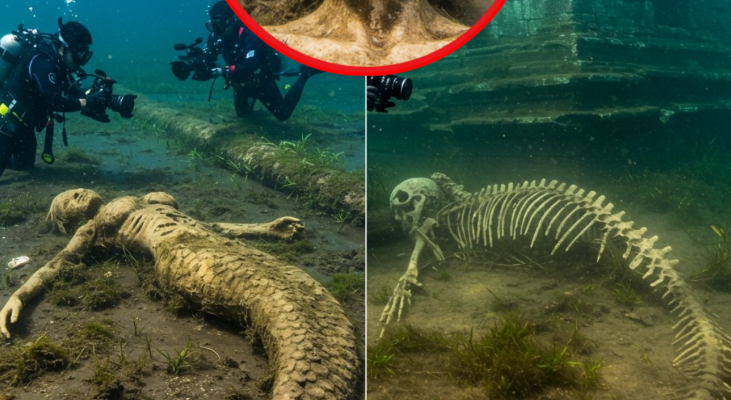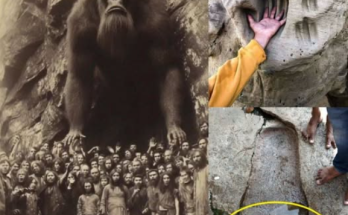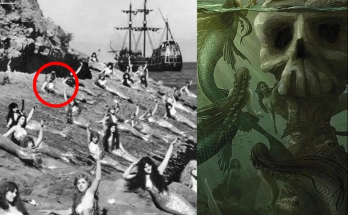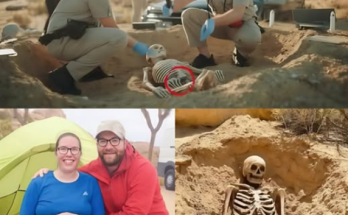The Discovery That Shook the Deep
It started as a routine dive off the volcanic coast of Santorini, Greece—a place where myth and mystery have danced for centuries. A team of marine archaeologists, searching for relics from ancient eruptions, plunged into an underwater cavern. What they found would send shockwaves through science, history, and every corner of the internet.
Resting silently on the ocean floor, half-buried in silt and coral, was a figure that defied all logic: a mummified mermaid.
The divers’ cameras captured what seemed impossible. The body, preserved by the cold, mineral-rich depths, had a human-like torso and arms, but below the waist, scales shimmered and a powerful tail curled, ending in a split fin. Leathery skin, intact after centuries, glowed eerily in the torchlight. Strands of dark hair fanned out around a skull-like face, its hollow eye sockets staring into the abyss.
When the footage surfaced, disbelief and awe exploded worldwide.
Viral Frenzy
Within hours, hashtags like #MermaidMummy and #OceanSecrets dominated social media. Millions dissected every frame: the ribcage arching through skin, the haunting face, the unmistakable tail. Comment sections turned into battlegrounds between believers and skeptics.
“Either we just uncovered the find of the millennium,” one user tweeted, “or we’re witnessing the most elaborate prank in history.”
Experts Weigh In
Marine biologists and anthropologists scrambled to respond. Dr. Helena Vargos of the International Oceanic Institute called it “a potential paradigm shift.”
“If authentic, this specimen could represent a lost branch of marine evolution—an intelligent aquatic hominid. It would rewrite everything we know about biology.”
But not everyone was convinced. Dr. Alan Prothero, a geneticist from Oxford, cautioned:
“Extraordinary claims require extraordinary evidence. Right now, we have a video—not proof. This could be an art project, or a composite designed to deceive.”
Ancient Clues & Cultural Shockwaves
Myths of mermaids span the globe—from Greek sirens to Japan’s ningyo, and Africa’s Mami Wata. The discovery’s location, near the ancient Minoan civilization, fueled speculation about forgotten rituals or even genetic experiments lost to time.
Dr. Lian Zhou, an expert in mythic archetypes, suggested:
“This could be evidence that myths are not mere imagination, but memories of encounters with beings now vanished.”
In coastal villages from Africa to the Caribbean, candles were lit and vigils held. Some called the mermaid’s return a spiritual omen.
The Mermaid’s Appearance
Preliminary descriptions stunned the world:
Elongated skull with hollow eye sockets.
Sharp, pointed teeth—more predator than human.
Human-like arms and hands, fingers curled as if reaching.
A six-foot tail ending in a dolphin-like fin.
Radiocarbon dating (unverified) suggests the body could be several centuries old.
One diver confessed, “It felt like it was watching us—even without eyes. I’ll never forget that chill.”
Hoax or History?
Skeptics argue the “mermaid mummy” could be a planted art piece, or a misidentified marine animal. Yet believers point to the seamless anatomy: the spine running from torso to tail, the fusion of human and aquatic features.
“Nature doesn’t lie,” insisted one diver. “This wasn’t stitched together. It was real.”
Governments Step In
The Greek Ministry of Culture quickly sealed off the site, citing archaeological protection. The remains were moved to a secure lab in Athens, sparking conspiracy theories about government cover-ups.
Marine activist Naomi Cruz warned:
“If genuine, governments may weaponize the discovery. That’s not science—that’s desecration.”
Theories Run Wild
Social media erupted with speculation:
Evolutionary Missing Link: Did humans once adapt fully to ocean life?
Ancient Genetic Engineering: Could advanced civilizations have merged species?
Extraterrestrial Origin: Does the “mermaid” resemble ancient alien hybrids?
Elaborate Hoax: Is this simply a crafted figure meant to fool the world?
Then, a leaked lab report (unverified) claimed DNA samples showed markers unknown to both humans and marine species. If true, this creature might belong to an undiscovered branch of Earth’s life—or something not of this world.



